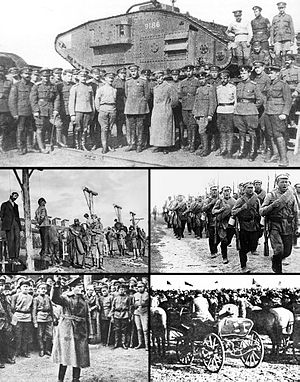- The treaty of B-L provided the context for the Civil War. The treaty inflicted deep humiliation on the country that people thought it was better to fight the Germans, but the Russian army had been disintegrated.
- The allied powers intervened in the civil war on the side of the white army to renew the war efforts in Russia against the Germans. They
 gave ammunition and supplies to the white army.
gave ammunition and supplies to the white army. - White army generals Kolchack and Denikin were dictator like themselves and wished to bring back the old order to Russia and keep the integrity of the Russian empire.
- Deep political divisions within the White army disabled it while the Red army was relatively united under the Bolshevik party. Also, the geographical distance between the White Army made communication difficult. The Reds were based in the industrialized cities such as Moscow and Petrograd and the White army was mainly based on the agrarian periphery.
- Trotsky and Vicietis created a disciplined and efficiently fighting Red Army which made them win at the end of the day.
- Civil war by eliminating class enemy, paved the way for the social revolution. It was an integral part of the Bolshevik program.
- The Red Army was led by Trotsky as the commissar of War and was crucial for the Bolshevik triumph. It was made up of peasants and workers and the Red Guard. Also strengthened by conscription of former Tsarist officers who were blackmailed in to entering the army by Trotsky.
- Numbered up to 5 million men by 1920. Because white forces were better trained, Trotsky sought the superiority in numbers.
- It became a model for the Soviet Government system, as well as shaping the attitudes of those who served it.
- Civil War was fought in two front’s; civilian and military. Operations against civilians: arrests and executions by Cheka and forced requisitioning of food from peasantry.
- 1st campaign in the winter of 1917-1918 eliminated the initial centres of anti-Bolshevik resistance in the south Urals and the Caucasus. By 1918, the Ukrainian government Rada was defeated.
- Advance of G forces in spring 1918 in to Estonia, Latvia Belorussia Ukraine led to overthrow of Bolshevik forces in that areas.
- Most decisive stage on March to Nov 1919. Collapse of German army eased the pressure on Bolsheviks in west. White coup on Omsk made Admiral Kolchak dictator and in the south General Denikin built up armed forces of southern Russia (AFSR) and in north gen. Yudenich built up a small force.
- The Red army was able to defeat them separately. Kolchak was thrown back to the Volga in May 1919.
- By Nov Denikin was 250 miles away from Moscow but retreated because of the stronger red army (they had bigger numbers).
- In Oct Yudenich made dash for Petrograd but Trotsky mobilized the working class and brought up reinforcements by rail from Moscow and whites were pushed towards Estonia.
